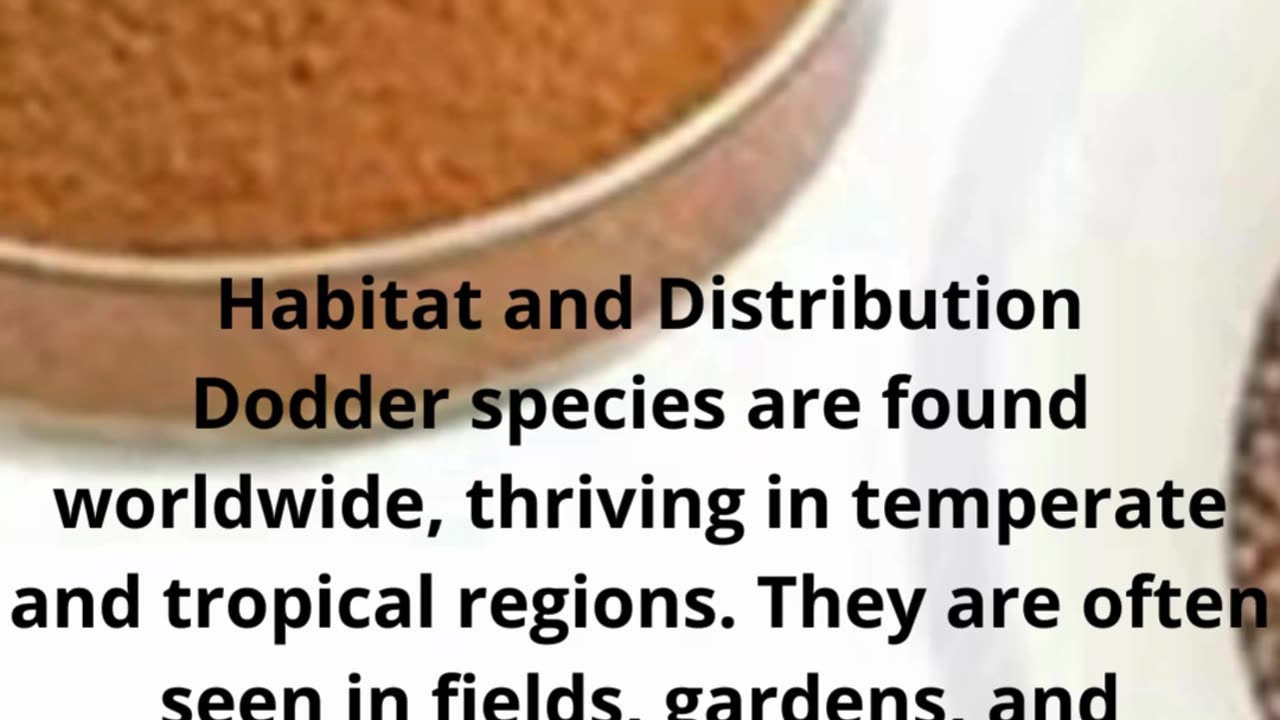Premium Only Content

Dodder Seed
Dodder Seed: A Comprehensive Overview
Botanical Profile
Dodder seed is derived from various species within the genus *Cuscuta*, a group of parasitic plants commonly referred to as dodder. These plants are known for their thread-like, twining stems and their ability to parasitize a wide range of host plants, extracting water and nutrients directly from them.
https://bit.ly/4a8YdR9
Physical Characteristics
The seeds of dodder are small, typically ranging in color from yellowish-brown to dark brown. They are hard and possess a rough, pitted surface which aids in their attachment and dispersal. Due to their resilient nature, dodder seeds can remain viable in the soil for several years, waiting for optimal conditions to germinate.
https://bit.ly/4a8YdR9
Habitat and Distribution
Dodder species are found worldwide, thriving in temperate and tropical regions. They are often seen in fields, gardens, and alongside roadsides, wherever suitable host plants are present. The seeds can spread through various means, including wind, water, and being inadvertently transported by animals or human activity.
https://bit.ly/4a8YdR9
Parasitic Nature
Dodder plants lack chlorophyll, making them unable to perform photosynthesis. Instead, they rely entirely on their host plants for sustenance. Upon germination, the young dodder seedling must quickly find a host; otherwise, it will perish. Once it attaches to a host, the dodder plant forms haustoria, specialized structures that penetrate the host's tissues and siphon off nutrients and water.
https://bit.ly/4a8YdR9
#### Medicinal Uses
Dodder seed has been utilized in traditional medicine, particularly in Chinese and Ayurvedic practices. It is believed to possess several health benefits, including:
- **Kidney Health:** Dodder seed is often used to support kidney function and treat related disorders.
- **Reproductive Health:** It is considered beneficial for enhancing fertility and treating sexual dysfunction in both men and women.
- **Liver Protection:** The seed is used for its hepatoprotective properties, helping to protect and detoxify the liver.
- **Vision Support:** Some traditional uses include improving eyesight and treating eye-related conditions.
https://bit.ly/4a8YdR9
Modern Research and Uses
Recent scientific studies have investigated dodder seed for its potential health benefits. Research has highlighted its antioxidant properties, possible anti-inflammatory effects, and its role in promoting overall wellness. However, comprehensive clinical trials are still needed to fully validate these traditional uses and understand the mechanisms behind them.
Caution and Toxicity
While dodder seed is used in traditional medicine, it's important to approach it with caution. The parasitic nature of the plant means it can sometimes accumulate harmful substances from its host. Therefore, sourcing from reputable suppliers and consulting healthcare professionals before use is crucial.
https://bit.ly/4a8YdR9
Conclusion
Dodder seed is a fascinating component of both botanical science and traditional medicine. Its unique parasitic lifestyle, combined with its potential health benefits, makes it a subject of interest for further research and application. However, due diligence and careful consideration are essential when incorporating dodder seed into health and wellness practices.
https://bit.ly/4a8YdR9
-
 7:35
7:35
Tactical Advisor
1 day agoNEW Springfield Prodigy Compact (FIRST LOOK)
285 -
 16:45
16:45
IsaacButterfield
1 day ago $0.25 earnedWoke TikToks Are DESTROYING The World
1.14K7 -
 1:09:27
1:09:27
State of the Second Podcast
13 hours agoThis is Why We Don’t Trust Politicians (ft. @stones2ndsense)
893 -
 10:19
10:19
Chrissy Clark
9 hours agoCNN’s BILLION Dollar Defamation Trial
1.18K -
 1:00:27
1:00:27
Trumpet Daily
16 hours ago $3.41 earnedCongress Humiliates Itself - Trumpet Daily | Jan. 15, 2025
4.08K9 -
 1:49:46
1:49:46
Glenn Greenwald
1 day agoTrump Fosters A Peace Deal With Israel & Gaza; Trump's Pressure On Israel Embarrasses His Enemies & Provides Foreign Policy Clues; Rubio & Hegseth On War And Militarism | SYSTEM UPDATE #389
89.9K157 -
 1:28:46
1:28:46
Donald Trump Jr.
16 hours agoOut of this World: Breaking News Investigation on Secret Alien Aircrafts, Live with Ross Coulthart & Lue Elizondo | TRIGGERED Ep.207
305K446 -
 1:39:31
1:39:31
Space Ice
12 hours agoSpace Ice & Redeye: Battlefield Earth & Rob Schneider
66.3K4 -
 1:33:38
1:33:38
Flyover Conservatives
1 day agoAMANDA GRACE | Prophetic Warnings Ignored: What Happens When Leaders Defy God | FOC Show
54.5K17 -
 59:57
59:57
The StoneZONE with Roger Stone
11 hours agoMEDICAL MURDER: A Sneak Peak into the Making of Died Suddenly 2 | The StoneZONE w/ Roger Stone
49.5K11